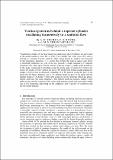Vortical patterns behind a tapered cylinder oscillating transversely
Author(s)
Techet, A. H.; Hover, F. S.; Triantafyllou, M.S.
DownloadTriantafyllou_1998_Vortical.pdf (982.7Kb)
Terms of use
Metadata
Show full item recordAbstract
Visualization studies of the flow behind an oscillating tapered cylinder are performed
at Reynolds numbers from 400 to 1500. The cylinder has taper ratio 40:1 and is
moving at constant forward speed U while being forced to oscillate harmonically
in the transverse direction. It is shown that within the lock-in region and above
a threshold amplitude, no cells form and, instead, a single frequency of response
dominates the entire span. Within certain frequency ranges a single mode dominates
in the wake, consisting of shedding along the entire span of either two vortices per
cycle (`2S' mode), or four vortices per cycle (`2P' mode); but within specific parametric
ranges a hybrid mode is observed, consisting of a `2S' pattern along the part of the
span with the larger diameter and a `2P' pattern along the part of the span with the
smaller diameter. A distinct vortex split connects the two patterns which are phaselocked
and have the same frequency. The hybrid mode is periodic, unlike vortex
dislocations, and the location of the vortex split remains stable and repeatable, within
one to two diameters, depending on the amplitude and frequency of oscillation and
the Reynolds number.
Date issued
1998Department
Massachusetts Institute of Technology. Department of Mechanical EngineeringPublisher
Cambridge University Press
Citation
Journal of Fluid Mechanics, 363, p.79-96 (1998)
Keywords
vorticity